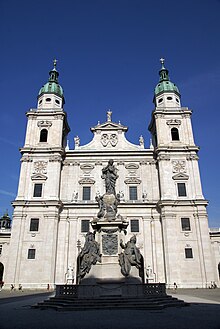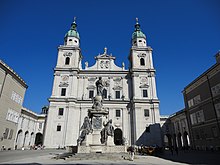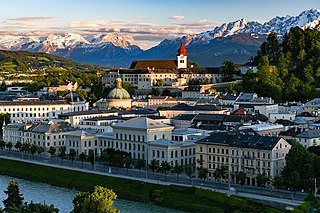
Salzburg is the fourth-largest city in Austria. In 2020, it had a population of 156,872.

The Prince-Archbishopric of Salzburg was an ecclesiastical principality and state of the Holy Roman Empire. It comprised the secular territory ruled by the archbishops of Salzburg, as distinguished from the much larger Catholic diocese founded in 739 by Saint Boniface in the German stem duchy of Bavaria. The capital of the archbishopric was Salzburg, the former Roman city of Iuvavum.
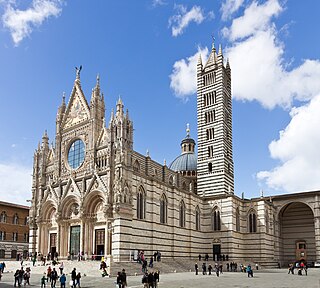
Siena Cathedral is a medieval church in Siena, Italy, dedicated from its earliest days as a Roman Catholic Marian church, and now dedicated to the Assumption of Mary.
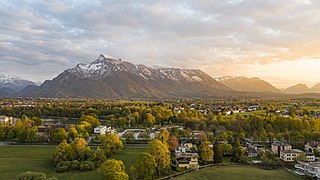
The Untersberg is the northernmost massif of the Berchtesgaden Alps, a prominent spur straddling the border between Berchtesgaden, Germany and Salzburg, Austria. The highest peak of the table-top mountain is the Berchtesgaden Hochthron at 1,973 metres (6,473 ft).
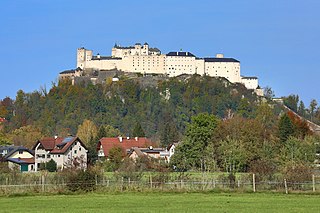
Hohensalzburg Fortress is a large medieval fortress in the city of Salzburg, Austria. It sits atop the Festungsberg mountain at an altitude of 506 m. It was erected at the behest of the prince-archbishops of Salzburg. The fortress is 250 m (820 ft) long and 150 m (490 ft) wide making it one of the largest medieval castles in Europe.

The Salzburg Residenz, also known as the Alte Residenz or Old Residence, is a palace located at Domplatz and Residenzplatz in the historic centre (Altstadt) of Salzburg, Austria. First mentioned about 1120, for centuries the Prince-Archbishops of Salzburg resided at the Residenz and used the palace to present and represent their political status. Today the Salzburg Residenz palace houses an art gallery, known as the Residenzgalerie, and is one of the most impressive attractions in the city.

Mirabell Palace is a historic building in the city of Salzburg, Austria. The palace with its gardens is a listed cultural heritage monument and part of the Historic Centre of the City of Salzburg UNESCO World Heritage Site.

The Mönchsberg, at 508 meters (1,667 ft) above sea level, is one of five mountains in the city of Salzburg in Austria. It flanks the western side of Salzburg's historic city centre, and forms part of the city's UNESCO World Heritage Site.

Residenzplatz is a large, stately square in the historic centre (Altstadt) of Salzburg in Austria. Originally named Hauptplatz, it is now named after the Alte Residenz of the Prince-Archbishops of Salzburg. It is one of the city's most popular places to visit.
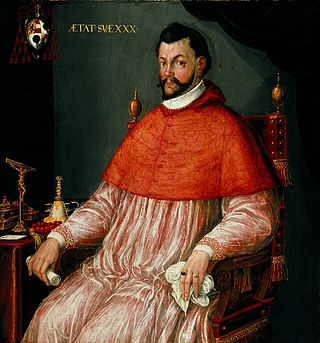
Wolf Dietrich von Raitenau was Prince-Archbishop of Salzburg from 1587 to 1612.

The Historic Centre of the City of Salzburg, also known as the Altstadt, is a district of Salzburg, Austria, recognized as UNESCO World Heritage Site since 1996. It corresponds with the historic city center, situated on the left and right banks of the Salzach river.

The Metropolitan Cathedral of Saint Agatha, usually known as the Catania Cathedral, is a Roman Catholic cathedral in Catania, Sicily, southern Italy. It was the seat of the Bishops of Catania until 1859, when the diocese was elevated to an archdiocese, and since then has been the seat of the Archbishops of Catania.
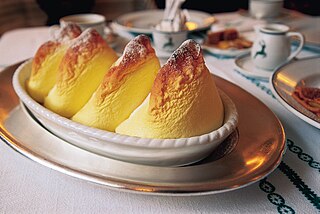
Salzburger Nockerl are a sweet soufflé served as a dessert, a culinary specialty in the Austrian city of Salzburg.

Fulda Cathedral is the former abbey church of Fulda Abbey and the burial place of Saint Boniface. Since 1752 it has also been the cathedral of the Diocese of Fulda, of which the Prince-Abbots of Fulda were created bishops. The abbey was dissolved in 1802 but the diocese and its cathedral have continued. The dedication is to Christ the Saviour. The cathedral constitutes the high point of the Baroque district of Fulda, and is a symbol of the town.

Mark Sittich von Hohenems was Prince-Archbishop of Salzburg from 1612 until his death.

Innsbruck Cathedral, also known as the Cathedral of St. James, is an eighteenth-century Baroque cathedral of the Roman Catholic Diocese of Innsbruck in the city of Innsbruck, Austria, dedicated to the apostle Saint James, son of Zebedee. Based on designs by the architect Johann Jakob Herkomer, the cathedral was built between 1717 and 1724 on the site of a twelfth-century Romanesque church. The interior is enclosed by three domed vaults spanning the nave, and a dome with lantern above the chancel. With its lavish Baroque interior, executed in part by the Asam brothers, St. James is considered among the most important Baroque buildings in the Tyrol.

The Holy Trinity Church is a Roman Catholic church in Salzburg, Austria. It was designed by Johann Bernhard Fischer von Erlach.

Franz Anton von Harrach zu Rorau was appointed coadjutor of Vienna and Titular Bishop of Epiphania in Syria in 1701, was from 1702 to 1705 Prince-Bishop of Vienna, 1705 coadjutor of Salzburg, and ruled from 1709 to 1727. He was considered one of the most notable Prince-Archbishops of Salzburg.

Mozartplatz, formerly known as Michaelsplatz, is a square in the historic centre of Salzburg in Austria. In the centre of the square is a statue in memory of the composer Wolfgang Amadeus Mozart, who was born in the city and after whom the square is now named.

Altenau Palace was a palace in Salzburg, Austria. Built in 1606, it was demolished in the 1720s to make way for the Mirabell Palace which stands on the same site. It was the home of prince-archbishop Wolf Dietrich von Raitenau.
